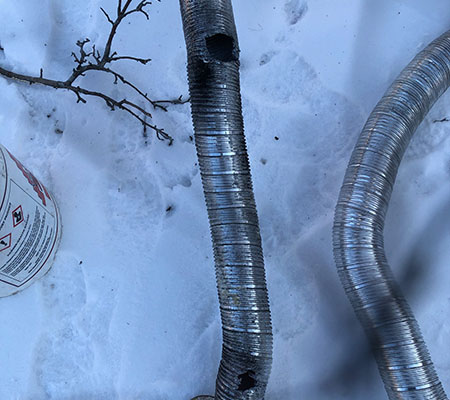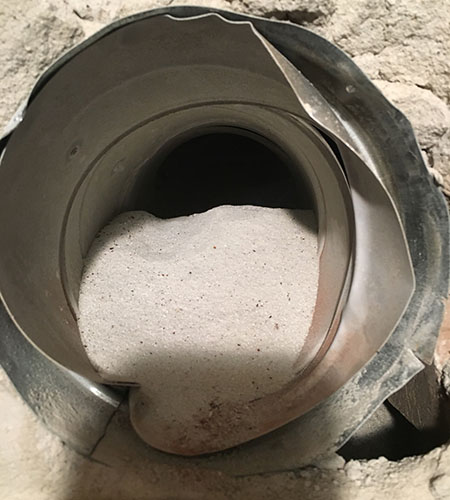Relining For Gas Appliance

Unlined or defective lining systems for your appliance systems pose a risk to, not only the structural integrity of your chimney and flue, but also can be a health and safety risk to the family members in your home. Your appliance chimney’s job is to move the byproducts, such as carbon monoxide and moisture, from your water heater, furnace, and boiler systems out of the home.
Why Is My Appliance Liner Failing?
There are several reasons you could be experiencing issues with your appliances venting properly.
- Clay Lined Appliance Flues: When appliances vent into masonry chimneys, the lining system is traditionally crafted with clay flue tiles. Over time, the gas and moisture put off by the appliances will begin to deteriorate the clay lining system. This can cause flue system failure, portions of clay flue tile to fall apart causing blockages, and gaps in the mortar joints of the chimney flue. It creates a situation where the flue system can no longer safely vent your appliances. These same byproducts will deteriorate the actual masonry structure surrounding the clay flue tiles, causing bricks to crumble, pop, and eventually fall apart completely. You may discover a white substance on the surface of your chimney caused by the moisture leaching out of the brick from the interior and depositing minerals onto the face of your chimney which can often be the first sign of a moisture issue within your flue system. In new construction, it is common practice to not vent appliances into masonry structures due to the volatility of this style of appliance ventilation.
- Aluminum Lined Appliance Flues: Often, when appliances are relined, the option to go aluminum vs. stainless steel is selected due to the cost difference between the two. Although aluminum is often the cheapest option, it is also the least durable with a large margin for failure. After the 1970’s Energy Crisis, there has been a race to manufacture appliances to be as efficient as possible. The more efficient the appliance becomes, the more corrosion resistance is needed within the ventilation system. Aluminum tends to not maintain structural integrity in corrosive environments, causing deterioration of the aluminum liner, reducing its life expectancy and posing a safety risk if not caught in a timely manner.
- Liner Sizing: Liner sizing is important for your appliances to vent appropriately. Whether the flue is over or undersized, both pose issues when it comes to the drafting of your appliances. It is important to understand that, when you are adding or removing an appliance, the required size of liner is subject to change. It is important to have the flue system inspected to ensure it can be maintained, or if any adjustments need to be made to adequately vent your appliances.
- Uncapped Appliances: By not having a chimney cap on your appliance flue system, you risk blockage from animals, nesting, or leaves/debris. It is important for the proper ventilation of your appliance flue to maintain a chimney cap to keep them out.

Do I Have To Rebuild My Appliance Chimney?
When your appliance chimney begins to deteriorate, rebuilding is generally a higher maintenance and the least cost effective solution. In new construction, a home's masonry appliance chimneys are a thing of the past! The more sustainable option is going to be to b-vent your appliance(s).
When we opt to b-vent an appliance, we will remove the chimney down below the roofline and dispose of the materials. If not currently lined with stainless steel liner, we will run a stainless steel liner from the roofline, down to the appliance connection. We will then replace the connections at the appliance with new, and make all connections to the appliance(s.) At the roofline, we will connect the stainless steel liner to a galvanized b-vent pipe that will extend out of the roof to code. Our technicians will then apply flashing, a new storm collar, ice and water shield, and patch the roof as needed with the best possible shingle match. This is all topped off with a rain cap installed at the top of the flue.
What If My Chimney Is In Good Condition Or Shares A Chimney With My Fireplace?
In the chance that your fireplace and appliance share a chimney, or your appliance chimney is still in great condition, we will opt to reline the appliance flue from the top of the existing chimney down to the appliance connection with stainless steel liner while still replacing galvanized connections, making all connections to your appliance(s), and installing a new rain cap as needed.
WHILE YOUR APPLIANCE FLUE MAY SHARE THE SAME CHIMNEY AS YOUR FIREPLACE, IT SHOULD NOT SHARE THE SAME FLUE SYSTEM. IF YOU SUSPECT THAT THIS IS THE CASE, IT IS IMPERATIVE TO HAVE A CSIA CERTIFIED CHIMNEY TECHNICIAN INSPECT YOUR FLUE SYSTEMS.
Do You Only Reline Appliance Flues With Stainless Steel?
We do! Stainless steel liners allow us to provide peace of mind that we are installing the most durable lining system on the market. Stainless steel chimney liners can withstand corrosive environments while keeping up with the increase of high efficiency appliances that are being installed.
We are confident enough to back our stainless steel appliance liner with a lifetime warranty!

